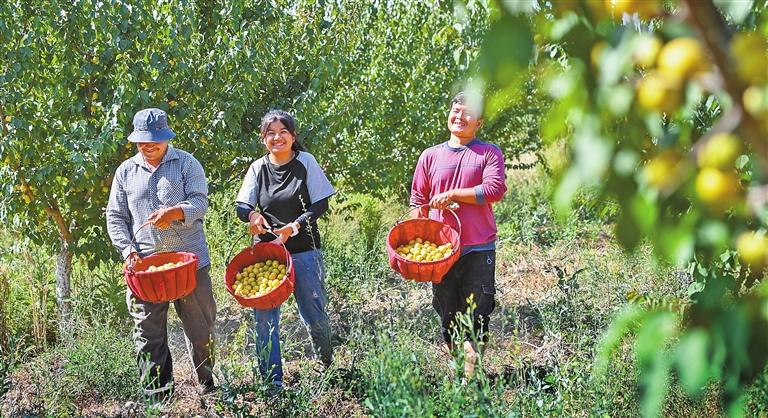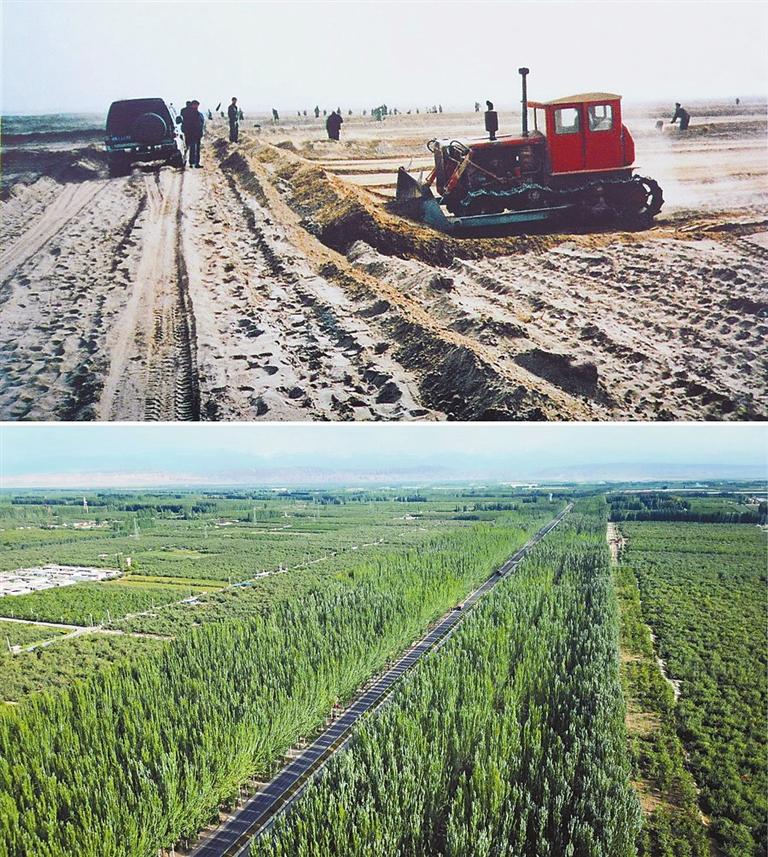

IMAM MEMET, aged 78, has played a crucial role in the fight against desertification in and around Kekeya, a remote location in Aksu Prefecture, in Northwest China’s Xinjiang Uygur Autonomous Region. “I am delighted to see the flourishing trees here, which will undoubtedly benefit future generations,” said Imam, as he took a leisurely stroll through the thriving woods that he has carefully nurtured over the course of several decades. Situated on the northern edge of the formidable Taklimakan Desert, Kekeya was previously known for its tumultuous weather and relentless sandstorms. The Taklimakan Desert spans an astonishing 337,000 square kilometers, slightly smaller than Germany, and is notoriously referred to as the “Sea of Death.” In 1986, an ambitious afforestation project was initiated in Kekeya to combat desertification and alleviate the adverse impacts of shifting sand and dust storms on nearby residents. Consequently, the “Green Great Wall” gradually took shape and became a notable feature of the area. The unwavering efforts to control desertification in Kekeya have yielded substantial economic and ecological benefits for the entire prefecture. Moreover, these remarkable achievements have sparked greater environmental awareness and participation among the general public. Birth of an oasis Over 40 years ago, the onset of spring often brought sandstorms, recalls 89-year-old Xie Fuping, a former Party chief of Aksu. Reflecting on the harsh living conditions faced by the people then, he says, “Sand often found its way into people’s rice bowls at meals.” Despite attempts made by their ancestors to address the issue during the Qing Dynasty (1644-1911), the outcomes were far from satisfactory. Historical records reveal that wells were dug near Kekeya to irrigate trees, but the costs were exorbitant and the wells eventually fell into disrepair. Before the founding of the People’s Republic of China in 1949, local residents made sporadic efforts to plant trees, but very few survived. In the 1960s, a project aimed at channeling water from a river in the city of Aksu was also abandoned. In 1985, Xie consulted with forestry, water resources, transportation, and other officials, and they unanimously agreed that tree planting should be the top priority for survival. Xie explains, “Kekeya was a major source of sand and dust storms, which had the most direct impact on the lives of the people.” Consequently, officials in Aksu resolved to establish windbreaks in Kekeya. “To seize the initiative of preventing and controlling desertification, planting trees in Kekeya was of paramount importance,” Xie says. In 1986, a team of over 250 people completed the construction of a 16.8-kilometer anti-seepage ditch in Kekeya in just four months to ensure a steady water supply for irrigation. Despite the lack of wages and access to large-scale machinery, a diverse group of officials, experts, and local residents in Aksu voluntarily gathered tools and food supplies to work in Kekeya. They labored tirelessly to soften the hardened soil, level the ground, and adjust soil alkalinity to create a suitable environment for tree growth. Imam, the first head of the Kekeya forestry station established in 1986, was determined to keep the trees alive. “They have to live at all costs,” he says. Imam and his colleagues resided on-site with construction blueprints, flashlights, and naan bread constituting their daily essentials. They diligently tended to the trees by watering, fertilizing, and managing them, traversing 20 to 30 kilometers each day. Esqer, Imam’s son, recalls that during that period, his father rarely returned home, and when he did, his face was invariably covered in dirt and his beard unkempt. “Once, when my father returned home, our guard dog failed to recognize him and began barking,” he says. Thanks to the unwavering efforts of these volunteers and forest rangers, approximately 80,000 hectares of forests were planted from 1986 to 2020 as part of the project. The number of dusty days in Aksu City, the major city near Kekeya, sharply decreased from about 100 days in 1980 to around 30 days in 2022. “I would feel a sense of guilt if I failed to take care of those trees that people had worked so hard to plant,” says Imam. An unfolding miracle “People have transformed Kekeya into a green oasis, from which we can also reap economic benefits,” said Fu Yiwen. He mentioned that his family secured a 0.13-hectare lease in 2007, and transformed the saline and alkaline land before planting apples. Benefiting from the existing irrigation system and windbreaks, Fu’s family could effectively water their apple orchards. They were also responsible for maintaining the adjacent windbreaks. “While soil fertilization is a difficult and demanding task, Kekeya’s success has given us the confidence to grow cash crops,” Fu said. His family has acquired an additional 2 hectares of land for tourism. Fu’s success exemplifies the government’s strategy of involving more people in forest preservation while stabilizing the income of locals through the cultivation of cash crops such as apples, walnuts, and jujube trees. The Aksu apple, known for its sweetness and juiciness, has become a prominent agricultural product of Xinjiang. Currently, over 86% of the trees in Kekeya’s afforestation project generate economic benefits. In 2022, the total fruit crop area in Aksu Prefecture reached 300,000 hectares, with farmers earning an average income of over 5,500 yuan (US$767) from fruits. This accounts for 26.25% of their annual earnings. In Aksu City’s Longtan Lake Park, Wu Weifan was busy slicing cucumbers, while his wife Ye Jing relaxed on a hammock, savoring a cup of tea. They had driven from Guangdong Province in their recreational vehicle (RV) for a holiday. Only four decades ago, Aksu grappled with raging winds and sandstorms that would make the streets invisible during spring, leading to class suspensions in the schools. Summer and autumn brought frequent floods that engulfed homes, while devastating wind disasters uprooted ripe fruit from orchards, posing risks to lives and property. Song Xingnian, head of the Kekeya memorial hall, recounted these challenges. Today, such issues are a thing of the past. “The air quality is good, the scenery is beautiful, and the people are warm,” said Ye. She added that the RV campground provides free water and electricity, creating a convenient and homey vibe for visitors. The lake park has become popular on the internet, attracting RV travelers from provinces like Liaoning, Hubei, and Shaanxi to its campground. Drawing from valuable experience gained from the Kekeya afforestation project, Aksu Prefecture has undertaken further ecological restoration and desertification control initiatives within the region since 2015. Lu Qi, chief scientist at the Chinese Academy of Forestry, says that China’s efforts in desertification control have transformed from a scenario where “sand forced humans to retreat” to one where “trees compelled sand to recede” over the course of several decades. Lu emphasizes that diverse approaches customized to specific regions and conditions have been explored, and Kekeya’s method has proven effective. (Xinhua) | 
